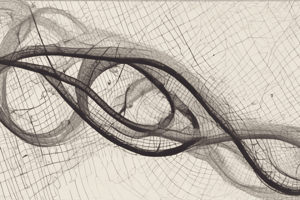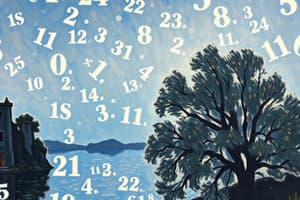Podcast
Questions and Answers
What does the factorial notation n! represent?
What does the factorial notation n! represent?
- Multiplication of all positive integers up to n (correct)
- Multiplication of all negative integers up to n
- Multiplication of all integers up to n
- Addition of all integers up to n
What is the value of 3!?
What is the value of 3!?
- 3
- 6 (correct)
- 12
- 9
Why is 0! equal to 1?
Why is 0! equal to 1?
- It follows a specific pattern
- It simplifies mathematical calculations
- By definition (correct)
- To confuse students in mathematics
How is the factorial of a non-negative integer n denoted?
How is the factorial of a non-negative integer n denoted?
What is the product of all positive integers less than or equal to 4?
What is the product of all positive integers less than or equal to 4?
In factorial notation, what does $n!$ equal to if $n=5$?
In factorial notation, what does $n!$ equal to if $n=5$?
How does the value of $n!$ change as n increases?
How does the value of $n!$ change as n increases?
What is the value of $1!$?
What is the value of $1!$?
Flashcards are hidden until you start studying
Study Notes
Combinations and Permutations: Understanding Factorial Notation
Combinations and permutations are fundamental concepts in mathematics that deal with ways of selecting objects from a set or arranging them in a specific order. These ideas have numerous applications in probability theory, counting problems, and more broadly in combinatorial analysis.
Factorial Notation
Factorial notation is used to represent the product of all positive integers up to a given number. For example, (n!) means (n\times(n-1)\times \cdots \times 2 \times 1). A simple rule can help you calculate it: To find the nth term of this sequence, multiply the previous term by n. For instance, starting with 1! = 1, which is the base case, we get 2! = 1 × 2 = 2, 3! = 2 × 3 = 6, etc..
The factorial of a non-negative integer (n), denoted by (n!), is defined as the product of all positive integers less than or equal to (n). This means that (0!=1), since there are no numbers to multiply when (n=0). As the value of (n) increases, so does the magnitude of its corresponding factorial.
In summary, factorial notation provides a concise way to express increasingly large products without having to write out each multiplication individually. It's especially useful in calculations where you're interested in finding the total number of different arrangements or combinations of items from a larger set.
Studying That Suits You
Use AI to generate personalized quizzes and flashcards to suit your learning preferences.




